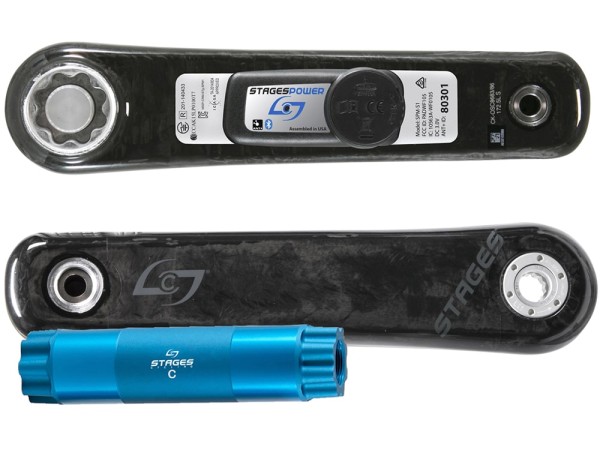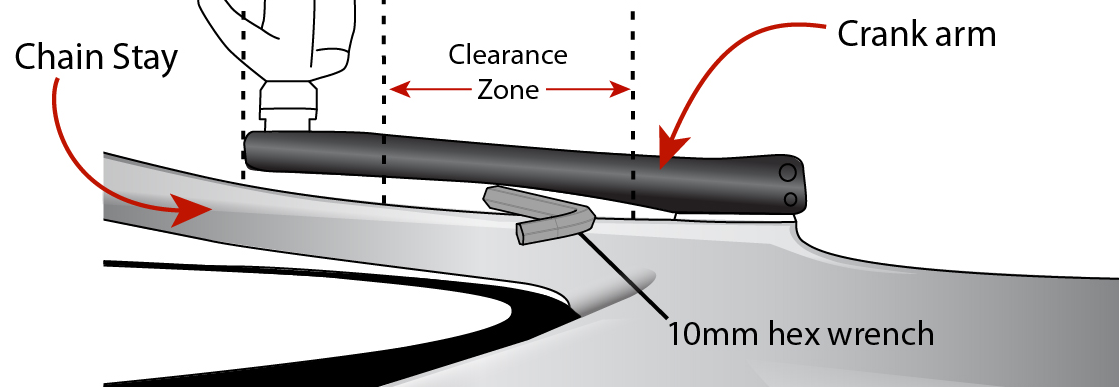
BEST PRICE GUARANTEEOn Many Items

MONEY-BACK-GUARANTEE
Relaxed shopping

EXPERT ADVICE
From athletes for athletes
PAYMENT METHODS
Stages Power L - Stages Carbon for SRAM, RaceFace, Easton, Specialized BB30 Gen3

Why choose Powermetershop?
- Order number: SW10814
The Stages Power L Carbon power meter is a single-sided power meter. It measures the power on the left crank arm. The Stages power meter is now available in the 3rd generation. It is positioned discretely on the inner side of the left crank arm, weighing in at a mere 15g. It's accurate (±1.5%) and easy to install. Stages L power meters always come mounted to the left crank arm. So all you have to do is find the model which is compatible with your existing crank set and simply swap the left crank arm.
By using different spindles it is compatible with a variety of cranks. Just choose the spindle that fits your crank:
A: SRAM Red 22 BB30, SRAM Red "2012" BB30
B: SRAM Force 22, Rival 22, Force/Rival CX1 BB30
C: SRAM MTB (9mm Spacer) & Easton EC90 SL
D: SRAM MTB (15mm Spacer)
E: Race Face Next SL (with 134.5 x 30mm spindle only)
F: Specialized S-Works Road
G: Sram DUB MTB
This power meter is not compatible with GXP cranks. Here you will find the matching GXP version.
Highlights and Downsides
- single-sided power measurement with high accuracy (± 1.5%)
- 200h battery life with a CR2032
- integrated cadence measurement
- very low weight (adds only 15g to the crank arm)
- excellent durability
- automatic temperature compensation
- easy to swap between bikes
- works with many bike computers and smartphones (ANT+ & Bluetooth)
- only left-sided measurement
- not compatible with other crank sets
Single-sided measurement
With the Stages Carbon Power L, only the left crank arm is equipped with measurement electronics. The power is doubled to estimate the total power. Staying in your training zones or pacing a long climb or a triathlon usually works very well with a single-sided power meter. It becomes more difficult when one leg is significantly stronger than the other. Then the total power deviates. The Stages Power L is therefore particularly suitable for riders who can do without the few last percent of accuracy.
Compatible bikes and cranks
The Stages Carbon power meter is compatible with a variety of cranks through the use of different spindles (overview see above). The power meter is mounted on the inside of the crank arm. Therefore, 10mm space is required between the crank arm and frame. With direct-mount brakes it is often too tight. You can check with a 10mm allen wrench whether a Stages power meter fits onto your bike. In the power meter area, the 10mm allen wrench must fit between the frame and crank arm:

Compatible bike computers and smartphones
Thanks to ANT + and Bluetooth Smart, the Stages power meter is compatible with all ANT + enabled bike computers and smartphones with Bluetooth Smart technology. With the 3rd generation transmission strength was increased by factor 6. Even triathlon watches, which were problematic with previous versions, now work seamlessly with the Stages power meter.
Construction and design
The left-sided Stages power meter sits well protected in a flat composite housing on the inside of the left crank arm. Strain gauges detect the slightest deformation of the crank arm due to the force applied to the pedal by the rider. Acceleration sensors are used to determine the cadence. This design makes it both discreet and well protected. Since the Stages power meter is firmly connected to the left crank arm, the crank arm is always included.
Tour tested
Stages has been very involved in professional cycling in recent years. The Stages power meter were thus represented in some Tour teams. In these extreme conditions for man and gear, the Stages power meter could prove itself.
Battery
The Stages Carbon power meter is powered by a standard CR2032 button cell. A battery is sufficient for about 200 hours of operation time. The CR2032 is widely used and inexpensive. It is available at almost every supermarket. The battery can be changed without tools. The LED on the power meter provides information about the battery level.
Weight
The actually power meter has a low weight of just 15g. The power meter is firmly connected to the left crank arm. The weight is therefore to be understood as additional weight to the crank arm.
Accuracy
We were able to confirm the accuracy of +-1.5% several times on our calibrated Cyclus II ergometer in the laboratory and in comparison with other power meters on the road. The measurement accuracy must be put into perspective somewhat, since the measurement is only one-sided.
Cadence
The cadence is determined by means of an accelerometer and an integrated ring laser and transmitted to the bike computer or smartphone. An additional cadence sensor is no longer necessary. Measuring cadence via acceleration sensors has long been a major challenge for engineers. In the 3rd generation of the Stages power meter, it now works perfectly.
Temperature compensation
When temperatures change, different materials expand differently. This can have a significant impact on the measurement accuracy of a power meter, as the strain gauges react to even the smallest changes. The Stages power meter therefore has active temperature compensation (ATC). This means that it delivers precise measurements even when temperatures change.
Calibration
Each individual Stages power meter is individually calibrated at the factory. Something else is the zero calibration (also called "Zero Offset" or "Manual Zero"), which should be done before every ride. This is similar to a scale that also "zeros" itself before weighing. For zero calibration, the Stages power meter must be active and connected to the bike computer or smartphone. The left crank arm must now point straight down. Now the zero calibration can be performed on the bike computer or smartphone.
Oval chainrings
The measurements of the Stages power meter are distorted by oval chainrings and are usually 4-5% higher than with round chainrings. The more oval the chainrings are, the greater the influence on the power readings.
Setup / Firmware Updates
Unlike other power meters, the Stages power meter does not need to be specially set up or registered. The correct crank length is already stored in the power meter. Firmware updates require the Stages App (Android & IOS) and a smartphone. We recommend always using the latest firmware of the power meter and the cycling computer.
Installation
The installation of the Stages power meter is very simple. The left crank arm of your crank is simply replaced by the Stages crank arm. For the installation of the Stages Carbon power meter you only need a common allen wrench. It's needed to loosen or tighten the bolt that pulls the left crank onto the axle.
Durability
We have made good experiences with the durability of the Stages power meter. Due to its placement on the inside of the left crank, the power meter is well protected against mechanical influences. In a crash, for example, a pedal power meter usually gets somewhat beaten up. This is where the Stages can score. The first generation had problems with the housings. The use of an unsuitable composite led to cracks forming in the housing and water being able to get inside. However, these problems have been completely resolved with the 3rd generation. However, it still happens occasionally that water gets inside. This is usually due to an improperly closed battery cover or an improperly fitted sealing ring. When replacing the battery, please make sure that the sealing ring is correctly seated and that the battery lid is fully locked.
Warranty and support
The Stages power meter comes with a 2 year warranty. The Stages power meters are manufactured in the USA in Boulder, Colorado. However, Stages also has a base in Germany, which is responsible for sales and support in Europe. The support is very good and extremely customer friendly. If there is ever a problem, we have a direct line to Stages Europe and can help you quickly.
Specifications
|
Sensor Location: |
left crank arm |
|
Accuracy: |
± 1.5% |
|
Weight: |
adds 15gr to left crank arm |
|
Battery Life: |
200+ hours (CR2032) |
|
Battery Replacement: |
Tool free |
|
Wireless Technology: |
ANT+, Bluetooth Smart Ready, NFC |
|
Firmware Upgrades: |
yes, wireless |
|
Compatible Software: |
Training Peaks, Strava, Garmin Training Center and others |
|
Power Range (Watts): |
0 to 2500 |
|
Cadence range (rpm): |
20-220 |
|
Crank Compatibility: |
SRAM BB30 Red 22, Force 22, Rival 22, Easton BB30 und SRAM BB30 MTB (168Q), Race Face Next SL, Specialized S-Works, SRAM MTB DUB |
|
Available lengths: |
170, 172.5, 175mm |
|
Active temperature compensation |
|
|
Accelerometer based cadence measurement |
|
In the pack
✔ Stages Carbon power meter
✔ Left crank arm
✔ Spindle
✔ Battery
✔ Manual
| Single or double sided: | left side |
| Crank manufacturer: | Easton, Race Face, Specialized, SRAM |
| Carbon or aluminum: | Carbon |
| Road or MTB: | MTB, Road |
Bewertungsdurchschnitt
I am using a Race Face Ne...
I am using a Race Face Next SL G5 on a Scott Spark RC 2022 bike with a Presfitt BB92 and I had to make adjustments. The tightening nut caused the spindle axle to come into an asymmetrical position relative to the frame. But I solved it by removing the tightening nut and using 3 pieces of 2.5 mm washers. Otherwise, it's my second powermeter stages v3 and I'm happy with it. Everything would be fine if there were 3 pieces of 2.5mm spacers with an inner diameter of 30mm in the set.
Excellent ! ...
Excellent !
Perfect support...
Perfect support
I am using a Race Face Ne...
I am using a Race Face Next SL G5 on a Scott Spark RC 2022 bike with a Presfitt BB92 and I had to make adjustments. The tightening nut caused the spindle axle to come into an asymmetrical position relative to the frame. But I solved it by removing the tightening nut and using 3 pieces of 2.5 mm washers. Otherwise, it's my second powermeter stages v3 and I'm happy with it. Everything would be fine if there were 3 pieces of 2.5mm spacers with an inner diameter of 30mm in the set.
Excellent ! ...
Excellent !
Perfect support...
Perfect support




